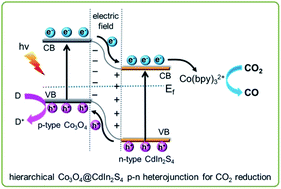Fabrication of hierarchical Co3O4@CdIn2S4 p–n heterojunction photocatalysts for improved CO2 reduction with visible light†
Abstract
Hierarchical Co3O4@CdIn2S4 p–n heterojunction photocatalysts, composed of ultrathin CdIn2S4 nanosheets supported on Co3O4 nanocubes, have been assembled through a facile solvothermal method for efficient CO2 reduction with visible light. The solution-processed surface growth strategy is advantageous to form an intimately coupled interface in situ for the Co3O4@CdIn2S4 hybrids with easily controllable compositions. Diverse physicochemical characterization experiments reveal that the Co3O4@CdIn2S4 heterostructures have more catalytically active sites, increased CO2 adsorption, as well as hampered recombination and accelerated separation and mobility of photoexcited charge carriers. As a result, the Co3O4@CdIn2S4 p–n heterojunction photocatalysts display greatly improved activity compared to their nanosheet-assembled CdIn2S4 counterpart, affording an optimal CO generation rate of 53 μmol h−1 (i.e., 5300 μmol h−1 g−1) and a high CO selectivity of 93.3%. Besides, the optimized Co3O4@CdIn2S4 photocatalyst has a high apparent quantum efficiency (AQE) of 1.87% under monochromatic light irradiation at 420 nm. Importantly, such metal sulfide composite photocatalysts also exhibit excellent stability against photocorrosion, due to the efficient hole transfer from CdIn2S4 to Co3O4. On the basis of the band structures and catalytic evaluation results, a possible CO2 photoreduction mechanism is further proposed.



 Please wait while we load your content...
Please wait while we load your content...